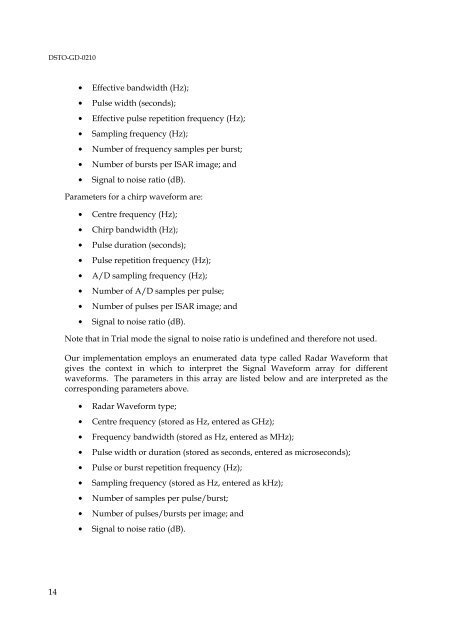ISARLAB - Inverse Synthetic Aperture Radar Simulation - Defence ...
ISARLAB - Inverse Synthetic Aperture Radar Simulation - Defence ...
ISARLAB - Inverse Synthetic Aperture Radar Simulation - Defence ...
- No tags were found...
You also want an ePaper? Increase the reach of your titles
YUMPU automatically turns print PDFs into web optimized ePapers that Google loves.
DSTO-GD-0210• Effective bandwidth (Hz);• Pulse width (seconds);• Effective pulse repetition frequency (Hz);• Sampling frequency (Hz);• Number of frequency samples per burst;• Number of bursts per ISAR image; and• Signal to noise ratio (dB).Parameters for a chirp waveform are:• Centre frequency (Hz);• Chirp bandwidth (Hz);• Pulse duration (seconds);• Pulse repetition frequency (Hz);• A/D sampling frequency (Hz);• Number of A/D samples per pulse;• Number of pulses per ISAR image; and• Signal to noise ratio (dB).Note that in Trial mode the signal to noise ratio is undefined and therefore not used.Our implementation employs an enumerated data type called <strong>Radar</strong> Waveform thatgives the context in which to interpret the Signal Waveform array for differentwaveforms. The parameters in this array are listed below and are interpreted as thecorresponding parameters above.• <strong>Radar</strong> Waveform type;• Centre frequency (stored as Hz, entered as GHz);• Frequency bandwidth (stored as Hz, entered as MHz);• Pulse width or duration (stored as seconds, entered as microseconds);• Pulse or burst repetition frequency (Hz);• Sampling frequency (stored as Hz, entered as kHz);• Number of samples per pulse/burst;• Number of pulses/bursts per image; and• Signal to noise ratio (dB).14
















